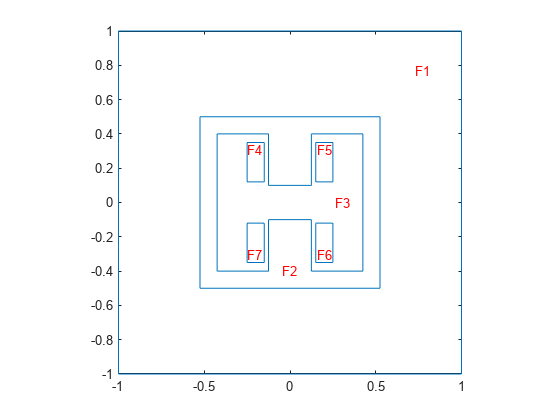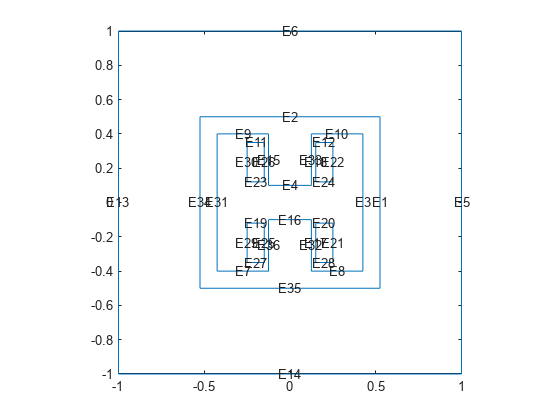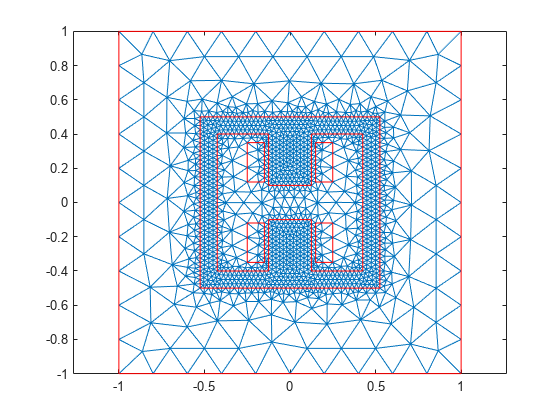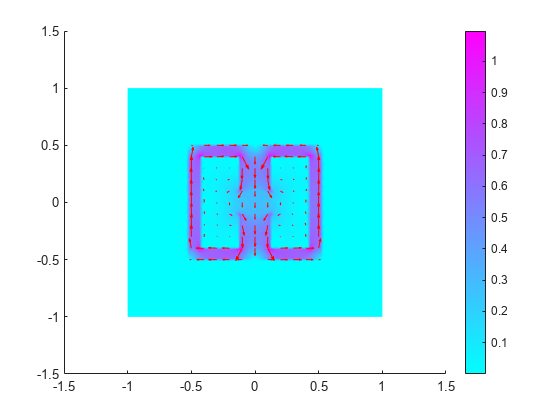Nonlinear Magnetic Permeability from B-H Curve
This example shows how to solve a 2-D nonlinear magnetostatic problem for a ferromagnetic frame with an H-shaped cavity. This setup generates a magnetic field due to the presence of two coils. First, calculate a solution using constant relative permeability. Then use the results as an initial guess for a nonlinear magnetostatic model, with the relative permeability depending on the magnetic flux density.
Create a geometry that consists of a rectangular frame with an H-shaped cavity, four rectangles representing the two coils, and a unit square representing the air domain around the magnet. Specify all dimensions in millimeters, and use the value 1000 to convert the dimensions to meters.
convfactor = 1000;
First, create the H-shaped geometry to model the cavity.
xCoordsCavity = [-425 -125 -125 125 125 425 425 ... 125 125 -125 -125 -425]/convfactor; yCoordsCavity = [-400 -400 -100 -100 -400 -400 ... 400 400 100 100 400 400]/convfactor; RH = [2;12;xCoordsCavity';yCoordsCavity'];
Create the geometry to model the rectangular ferromagnetic frame.
RS = [3;4;[-525;525;525;-525;-500;-500;500;500]/convfactor]; zeroPad = zeros(numel(RH)-numel(RS),1); RS = [RS;zeroPad];
Create the geometries to model the coils.
RC1 = [3;4;[150;250;250;150;120;120;350;350]/convfactor;
zeroPad];
RC2 = [3;4;[-150;-250;-250;-150;120;120;350;350]/convfactor;
zeroPad];
RC3 = [3;4;[150;250;250;150;-120;-120;-350;-350]/convfactor;
zeroPad];
RC4 = [3;4;[-150;-250;-250;-150;-120;-120;-350;-350]/convfactor;
zeroPad];Create the geometry to model the air domain around the magnet.
RD = [3;4;[-1000;1000;1000;-1000;-1000; ...
-1000;1000;1000]/convfactor;zeroPad];Combine the shapes into one matrix.
gd = [RS,RH,RC1,RC2,RC3,RC4,RD];
Create a set formula and create the geometry.
ns = char('RS','RH','RC1','RC2','RC3','RC4','RD'); g = decsg(gd,'(RS+RH+RC1+RC2+RC3+RC4)+RD',ns');
Plot the geometry with face labels.
pdegplot(g,FaceLabels="on")
Plot the geometry with edge labels.
figure
pdegplot(g,EdgeLabels="on")
Create a magnetostatic model and include the geometry in the model.
model = femodel(AnalysisType="magnetostatic", ... Geometry=g);
Generate a mesh with fine refinement in the ferromagnetic frame.
model = generateMesh(model,Hface={2,0.025}, ...
Hmax=0.2, ...
Hgrad=2);Plot the mesh.
figure pdemesh(model)

Specify the vacuum permeability value in the SI system of units.
mu0 = 1.25663706212e-6; model.VacuumPermeability = mu0;
Specify a relative permeability of 1 for all domains.
model.MaterialProperties = materialProperties(RelativePermeability=1);
Now specify the large constant relative permeability of the ferromagnetic frame.
model.MaterialProperties(2) = ...
materialProperties(RelativePermeability=10000);Specify the current density values on the upper and lower coils.
model.FaceLoad([5 6]) = faceLoad(CurrentDensity=1e6); model.FaceLoad([4 7]) = faceLoad(CurrentDensity=-1e6);
Specify that the magnetic potential on the outer surface of the air domain is 0.
model.EdgeBC(9:12) = edgeBC(MagneticPotential=0);
Solve the linear magnetostatic model.
Rlin = solve(model)
Rlin =
MagnetostaticResults with properties:
MagneticPotential: [6373×1 double]
MagneticField: [1×1 FEStruct]
MagneticFluxDensity: [1×1 FEStruct]
Mesh: [1×1 FEMesh]
Specify the data for the magnetic flux density B and the corresponding magnetic field strength H.
B = [0 .3 .8 1.12 1.32 1.46 1.54 1.61875 1.74]; H = [0 29.8 79.6 159.2 318.31 795.8 1591.6 3376.7 7957.8];
From the data for B and H, interpolate the H(B) dependency (B-H curve) using the modified Akima cubic Hermite interpolation method.
HofB = griddedInterpolant(B,H,"makima","linear"); muR = @(B) B./HofB(B)/mu0;
Specify the relative permeability of the ferromagnetic frame as a function of B, .
model.MaterialProperties(2) = ... materialProperties(RelativePermeability= ... @(~,s) muR(s.NormFluxDensity));
Specify the initial guess by using the results obtained by the linear solver.
model.FaceIC = faceIC(MagneticVectorPotential=Rlin);
Solve the nonlinear magnetostatic model.
Rnonlin = solve(model);
Plot the magnitude of the flux density.
Bmag = sqrt(Rnonlin.MagneticFluxDensity.Bx.^2 + ... Rnonlin.MagneticFluxDensity.By.^2); figure pdeplot(Rnonlin.Mesh,XYData=Bmag, ... FlowData=[Rnonlin.MagneticFluxDensity.Bx ... Rnonlin.MagneticFluxDensity.By]) axis equal

References
[1] Kozlowski, A., R. Rygal, and S. Zurek. "Large DC electromagnet for semi-industrial thermomagnetic processing of nanocrystalline ribbon." IEEE Transactions on Magnetics 50, issue 4 (April 2014): 1–4. https://ieeexplore.ieee.org/document/6798057.